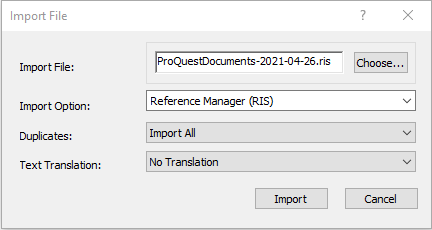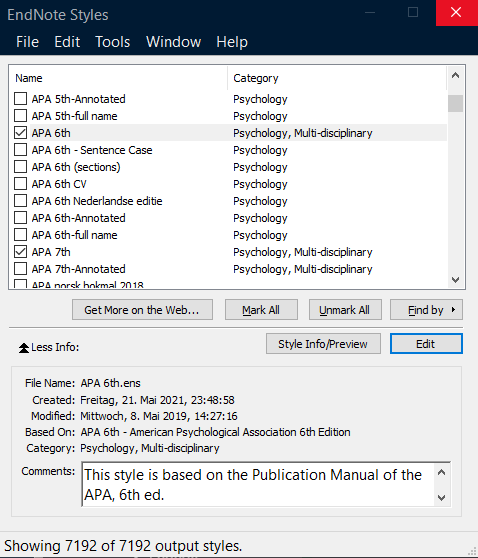- Basic information
- Workshops & guides
- Managing references
- Managing citation styles
- Cite While You Write
Basic information
WU has a campus-wide license for the reference management software EndNote, making it available to all WU students, faculty, and staff free of charge.
Note: You can find information on the web-based application EndNote Web on a seperate page: EndNote Web.
Installation
Private Computer
WU students and employees will find a link to the software download in the Control Panel where the program can be downloaded. After agreeing to the license terms, you will also receive a file with a license key (“Product Key”). Install the downloaded program and copy the license key into the appropriate field when prompted.
Workstation
On the workstations, EndNote X9 and EndNote 20 are provided via the Software Center for easy installation. Only one of the two versions can be installed. Any existing installation will be replaced by a newly selected one.
Workshops & guides
Library workshops
The WU Library regularly offers introductory courses for EndNote and other reference management software. You can find the current schedule on our website.
search_bar
In addition, every Tuesday you have the opportunity to visit the search_bar – no registration necessary! The search_bar offers advice on all questions concerning reference management.
Guides
Below you can find an overview of the most important functions and WU-specific settings.
Managing references
Creating references manually
Select References » New Reference or click on the plus-icon above the literature entries.
Select the appropriate document type: this determines which fields are available and how the citation and bibliography entry are formatted.
Fill in the bibliographic fields. Observe the formal requirements for entering names! Dates must be entered as they are to appear in the bibliography. Line breaks separate individual entries in name fields, as well as in the URL and Keywords fields. In all other cases, line breaks as saved in the input field are also applied in the bibliography!
Entering names
Names should be entered directory style, i.e. last name(s), first name(s), so that the program will know how to format them depending on the required context. Anything in front of the comma will be sorted as the last name, anything after the comma counts as the person’s first name or names. Aristocratic titles like von, van, or de are given as part of the first name:
- Judith Butler
Butler, Judith - Johann Matthias von der Schulenburg
Schulenburg, Johann Matthias von der
Suffixes found at the end of a name must be listed after a second comma:
- George Bush Sr.
Bush, George, Sr.
The names of organizations, companies, etc. are listed with a comma at the end:
- International Monetary Fund
International Monetary Fund,
If an institution’s name includes one or more commas, insert a second comma immediately after the first and leave off the closing one:
- Ministerium für Wissenschaft, Forschung und Wirtschaft
Ministerium für Wissenschaft,, Forschung und Wirtschaft
Entering multiple authors
Multiple authors of the same work are entered in the same entry field. Each author is entered on a separate line:

Importing references
Importing in RIS format
The file format .ris is an exchange format for literature management programs. Almost all databases and library catalogs offer an export in this format. EndNote can open these files directly during download. Alternatively, you can perform the import from EndNote:
- Click on File » Import » File…
- Locate the file on the hard drive by clicking Choose …
- Select Reference Manager (RIS) as the import option and click Import.

Direct export to EndNote Web
Some databases offer a direct export of references to EndNote Web (e.g. EBSCO). If you synchronize your EndNote database with EndNote Web, this option can be used.
You can find more detailed information on EndNote Web here.
Research in EndNote
EndNote itself offers the possibility to search databases and library catalogs directly. For technical reasons, however, this often only makes sense if you already know what you are looking for. For example, if you already have a document and you want access its data. Select a suitable resource in the left column under Online Search. The search form above the literature list now shows you the search fields configured for the resource. Enter the search terms as precisely as possible, otherwise you may receive far too many hits.
Add new resource for Online Search
Under Online Search click more… and select the desired database or library catalog from the list. Resources that were not supplied by EndNote can be upgraded with a Connection File, if necessary. Place the necessary file in the designated folder (by default Documents/EndNote/Connections – you can look up or configure the actual path under Edit » Preferences » Folder Locations). The resource is immediately available and can be selected as described above.
Appropriate resources for searching for articles online:
- Bus Source Prem (EBSCO Business Source Premier): Connection to WU’s VPN is required.
Appropriate resources for searching books online (especially ISBN search):
- WU Catalog: Download the Connection file here.
- Austrian Library Network (Österreichischer Verbundkatalog): Download the Connection file here.
- K10Plus Verbundkatalog: Download the Connection file here.
- Library of Congress (integrated in EndNote)
Managing groups
To sort your references, EndNote offers the possibility to create groups: Under Groups » Create Group you can access this function.
Managing citation styles
Citation styles specify how citations in the text and the bibliography are formatted. EndNote provides a large number of styles out of the box, which can be managed in the menu under Tools » Output Styles » Open Style Manager. To enable an existing style for use in EndNote and in Cite While Your Write for Word, mark it with a check mark.

If the style you are looking for is not available, you can search for it by clicking on Get More on the Web… on the EndNote page. Citation styles from WU institutes, departments and programs can be found here. Save the downloaded file in the citation style folder (by default Documents/EndNote/Styles – you can look up or configure the actual path under Edit » Preferences » Folder Locations. The style is immediately available and can be activated as described above.
If the citation style you want is not available anywhere, please contact the library at library@wu.ac.at.
Cite While You Write
Cite While You Write (CWYW) is a plugin for MS Word on Windows and Mac OS, and for Writer on Mac OS, that lets you insert and format references from EndNote and create bibliographies automatically.
Installation and set-up
When installing EndNote, the CWYW plugin is automatically installed as well.
Selecting a citation style
Under Style, select the citation style you want. The styles that you have activated in EndNote are available.
Inserting a citation
- In your text, place the cursor where you want to insert your citation.
- Click on Insert Citations in the EndNote toolbar.
- Enter the author or title of your reference in the search window. You can restrict your results to the year of publication, as well.
- Double-click on the reference you want to insert. It will also automatically be added to the bibliography at the end of your paper.
Inserting a citation as a footnote
- Insert a footnote.
- Place your cursor in the footnote and proceed as described in steps 3 and 4 above.
Editing and deleting citations
To add page numbers or prefixes like cf., see, etc., right click on the citation and select Edit Citations » More. In the editing window under Edit Citation you can then add the additional data.
Deleting references
If you want to delete a reference from the text, do not just use the delete key on your keyboard, as this could create problems with your bibliography. Right click on the reference and select Edit Citations » More. Click the citation you want to delete under Edit Reference » Remove Citation and then click OK.
Updating references
When you have edited a reference in EndNote, changes are not automatically implemented in your Word document. To make these changes, you have to select Update Citations and Bibliography in the in the EndNote toolbar.
Inserting secondary quotations
Please note: Generally, secondary quotations are best avoided in academic writing and should only be used if it is impossible to obtain the original source.
EndNote doesn’t offer the option to automatically insert secondary quotations. You have the following options:
- If only the secondary source should appear in your bibliography, insert the details of the original source as regular text and the secondary source as an EndNote reference, following the guidelines.
- If both the original and the secondary source should appear in the bibliography, it gets a bit more tricky:
- Insert both citations (original and secondary) with EndNote so that both appear in the bibliography.
- Write the citations as regular text next to them in the desired format.
- Hide the EndNote citations by selecting them and using the font formatting menu (CTRL+D or right-click » Font) to check “Hidden.” You can still see the citations while editing, but they won’t be visible in print or when exporting to PDF.
